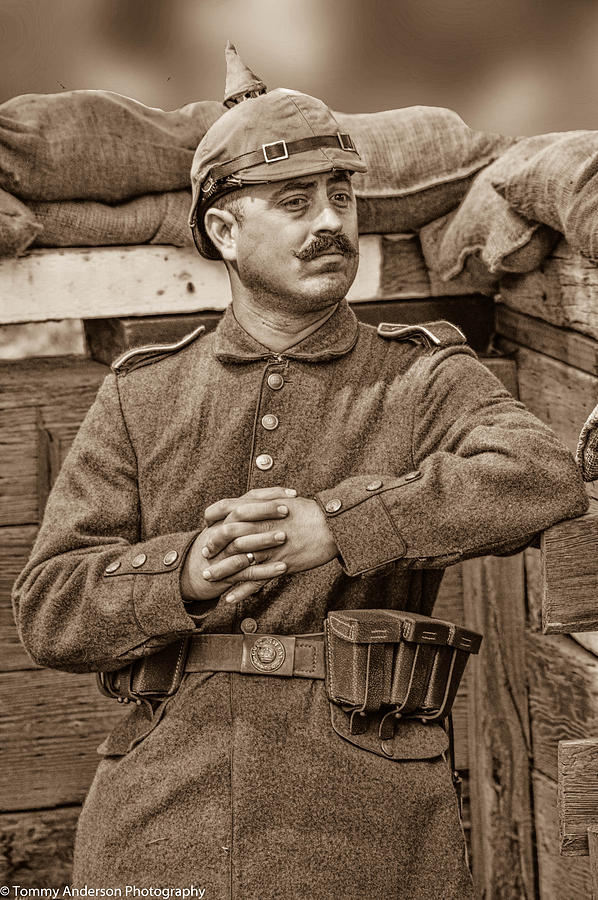
World War 1 German Officer 2 Photograph by Tommy Anderson Fine Art America
The military luxury of maintaining the variety of uniforms could only be supported under peacetime conditions. The outbreak of war forced the German army to simplify it's field uniform. This occurred twice in 1915, and again in 1917. This is a photo of a young Prussian N.C.O. circa 1912 in his dress uniform.

Пин на доске World War 1
Color poster showing the insignia, patches, hats and uniforms of the German Army. The poster features two figures: one is a German soldier wearing the gray-green wool field uniform and the other is a German soldier wearing the olive cotton tropical (Afrika Korps) uniform.. Since before World War I German and Austrian mountain troops had worn.

German uniforms More German Soldiers Ww2, German Army, Military Art, Military History, World War
Historian Dan Snow models a French army uniform from early World War I in a BBC segment. As the war progressed, the uniforms changed. France was the first to add helmets, and they adopted a uniform cloth that would incorporate red, white, and blue threads. A lack of red dye — it was manufactured in Germany — made the resulting fabric light.

Early war German uniform grouping. World War One, First World, German Uniforms, Military
The British wore khaki uniforms throughout World War One. These uniforms had originally been designed and issued in 1902 to replace the traditional red uniform and remained unchanged by 1914. A formative shot of men of the original Rhodesian Platoon of the King's Royal Rifle Corps, 1914. Image credit: Public Domain, via Wikimedia Commons.

Colorized photo of two German Soldiers during the First World War 1914 OldSchoolCool
It is a German uniform of that era. The biggest hints are the cut of it, as visible, the classicist font used for the number on the shoulder boards, and most important: the two cockades on the hat.. The German Army in World War One", Bloomsbury: London, New York, 2016.

German Sturmtruppen Uniform. Военный, Военные, Военная форма
The German Army of 1914 went into battle in a uniform little changed from the 19th Century. In 1910, the Army field uniform was modernized, mainly by changing the color from blue to field grey. The modernized uniform standards maintained the rank insignia for Officers and Non-Commissioned Officers, most of which had been in use since the 18th.

Picture World war one, World war i, Military history
WW1 German Imperial Army P07/10 enlisted man tunic £ 119.00 Select options; WW1 German Imperial Army P07/10 enlisted man tunic BLACK £ 139.00 Select options; WW1 German Imperial Army pattern 1914 tunic - World War One German army £ 119.00 Select options; WW1 German Imperial Army pattern p08 officers uniform £ 215.00 Select options; 1; 2; →

Image result for ww1 german uniforms World war, World war one, World war i
World War 1 German Uniform and equipment, M1915 Tunic & standard issue Wool Trousers The store will not work correctly in the case when cookies are disabled.. WW1 German Custom Gas Mask Canister - 3 Colour Camo . £44.95. In stock. Buy Now. WW1 German Naval Belt . £49.95. In stock. Buy Now. Imperial German Navy EM Buttons - 19mm.

The German Army 1914 to 1918. German army, German uniforms, World war one
History Bunker Ltd World War 1 and World War 2 reproduction military uniforms. Since 2006 the company and product range has grown rapidly and we now carry over 1000 product lines including WW1 British Army uniforms, WW1 Anzac uniforms, WW1 German uniforms, WW2 Soviet Red Army uniforms, WW2 Italian uniforms, WW2 Japanese uniforms as well as British Napoleonic, Crimean and Victorian uniforms

WW1 German enlisted man Uniform feldmutz and webbing
Back to PART I of Germany Army 1914-1918. At the outbreak of World War One in August 1914, the German Army was uniformly dressed in field-gray uniforms, which had been introduced in Prussia by the 'All Highest' cabinet orders of 23 February and 18 March 1910. The color of the first field gray was much lighter, and not as green, as that.

German soldier during WWI. The flowers into their uniforms are an indication that they will be
WWI German Militaria. From 1871 until 1918, the German Reich ruled over 27 territories, building its army into one of the world's strongest, with a navy that was outpaced only by the British Royal Navy. As a result, the German uniforms, helmets, and other military gear from World War I were representative of an enormous force that was.

Pin on The Great War World War I
World War One (WW1) Imperial German Uniform Combo Pack contains:1 M1910 Tunic, 1 Trouser, 1 shirt, 1 Fieldmutze Cap and a pair of Puttees. Shipping included in price. Shipping included in price. Chest Size For Tunic

Pin on WWI
Media in category "Uniforms of the German imperial army of World War I". The following 200 files are in this category, out of 215 total. 01917 Infanterieregiment 377, 1. Bataillon.jpg 800 × 579; 100 KB. 2012. День Победы в Донецке 280.jpg 4,928 × 3,264; 7.35 MB. 2012.

German Soldier Ww1 Telegraph
During World War II, the German uniform evolved to meet the demands of various theatres of battle and the climate conditions encountered within them. For example, a white camouflaged parka-and-pants set were developed expressly for the harsh winter conditions of the Eastern Front. For the hot, dry desert conditions of North Africa, German.

WW1 German Imperial Army pattern p08 officers uniform The History Bunker Ltd
Bavarian military Pickelhaube, low helmet bell Prussian police leather Pickelhaube. The Pickelhaube (German: [ˈpɪkl̩ˌhaʊ̯bə] ⓘ; pl. Pickelhauben, pronounced [ˈpɪkl̩ˌhaʊ̯bn̩] ⓘ; from German: Pickel, lit. 'point' or 'pickaxe', and Haube, lit. 'bonnet', a general word for "headgear"), also Pickelhelm, is a spiked leather or metal helmet that was worn in the 19th and 20th.

DEUTSCHES HEER soldier of the 116th Grenadier Regiment of the army of the German state of
Lost Battalions is the manufacturer of the most accurate reproduction German World War One and Two uniforms available. We are not the biggest company in the business and we realy don't wish to be. Our customers are those "hardcore authentic" reenactors, collectors, and museums who demand the greatest level of accuracy attainable in a reproduction.